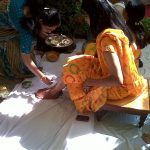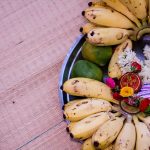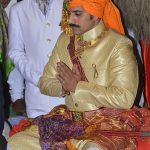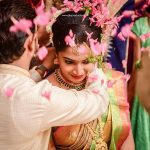Punjabi weddings are filled with fun, laughter and celebration. The over-the-top approach to celebrations in Punjabi culture makes a Punjabi wedding very interesting and unique. Read on if you have been invited to a Punjabi wedding and want to understand what each of the Punjabi wedding rituals means.
Punjabi Pre Wedding Rituals
Roka: The Roka is a ceremony that takes place before the engagement. It is when the friends and families of the bride and the groom gather together for the first time. Gifts are exchanged and it is a festive occasion.
Kurmai: The couple exchange rings in the engagement ceremony. The bride wears an ornate dupatta called the Fulkari that could be new or a family heirloom. The bride’s mother and sister-in-law help her wear jewellery and apply a Henna paste dot to her palm. The bride’s father applies a Tikka to the groom and blesses him. The friends and family present congratulate the couple and exchange gifts.
Dholki or Sangeet: The bride’s family hosts the Sangeet , and a few members of the groom’s family attend. There is fun, music and laughter. Traditionally, the bride’s family would sing and play music, but in modern times, the Sangeet calls for the services of the DJ. The bride may host a sangeet for her close female friends and family.
Mehndi: The Mehendi is a function when Henna designs are applied to the hands and feet of the couple. The friends and family present may also choose to have Henna applied to their palms. Bindis and bangles are displayed in a basket, and the female guests can pick from them, choosing colours and designs to match the outfit they will wear to the wedding. The Mehendi happens individually at the bride’s and groom’s homes.
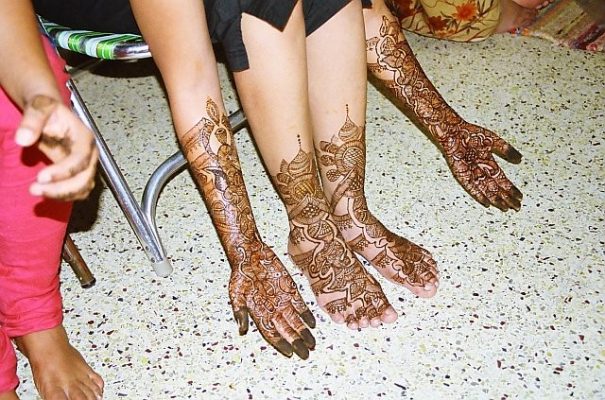
Punjabi Bride Wedding Rituals
Mayian: The Mayina rituals start on the day before the wedding ceremony. It includes rituals such as the Batna, Choora, and Jagoo. Sometimes the Sangeet and Mehndi are combined with the Mayian rituals. The Mayian rituals differ based on the region of Punjab and the family traditions.
Choora: The Choora ceremony happens on the day of the wedding. The bride’s maternal uncle and aunt give her Choora or red bangles after all the people present bless the bangles. They bless her by throwing flower petals on her head. The other friends and relatives present attach decorative gold or silver ornaments called Kaliras to the bangles.
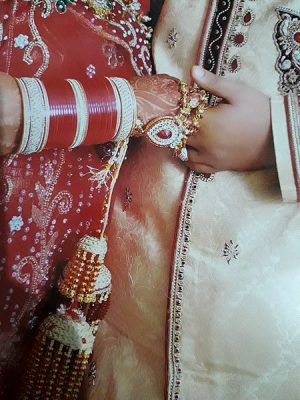
Shaint or Vatna Haldi Ceremony: The Punjabi pre-wedding rituals include a Haldi ceremony. The bride sits facing four lamps that cast a flattering light on her face. The women present make a paste of turmeric (Haldi) powder and mustard oil and then apply it to her face and body. This is a skin treatment that enhances the bride’s looks before the wedding.

Ghara Gharoli: The bride’s Bhabi (brother’s wife) brings her a decorated pitcher (called Ghadoli) of water taken from a nearby temple. The bride bathes in thai holy water and dresses in her bridal finery given to her by her maternal uncle. A similar ceremonial bath happens at the groom’s house.
Jaggo: The Jagoo is a ceremonial celebration at the bride’s and groom’s homes that happens in the wee hours of the night. The family decorates a copper or brass vessel (Khaddah) with earthen lamps and the maternal aunt of the bride or the groom (respectively) carries it on her head accompanied by a woman carrying a stick with bells on it. There is food, drink and a general air of merriment and celebration.

Punjabi Groom’s wedding rituals
Sarvala: The groom’s Sarvala or caretakers is a young boy from his family who dresses just like the groom.
Sehrabandi: The Vatna and Ghara Gharoli happen at the groom’s house and the groom emerges dressed in his wedding finery. A pooja is performed. The groom’s sister ties a Sehra on his head and those present give the groom gifts of cash for good luck.
Ghodi Chadna: The groom’s Bhabhi lines his eyes with Kohl to keep him safe from the evil eye. His sisters and cousins feed the groom’s horse. The groom mounts the horse and sets off to the wedding venue.
Punjabi Wedding Rituals Details
Milni: The elders of the bride’s family and the groom’s family are introduced during this ceremony. The bride’s relatives give Shagun or auspicious gifts to the boy’s relatives in order of age.
Jaimala/Varmala: The bride and the groom exchange flower garlands in the Varmala ceremony. This is a symbol of their acceptance of each other in marriage.
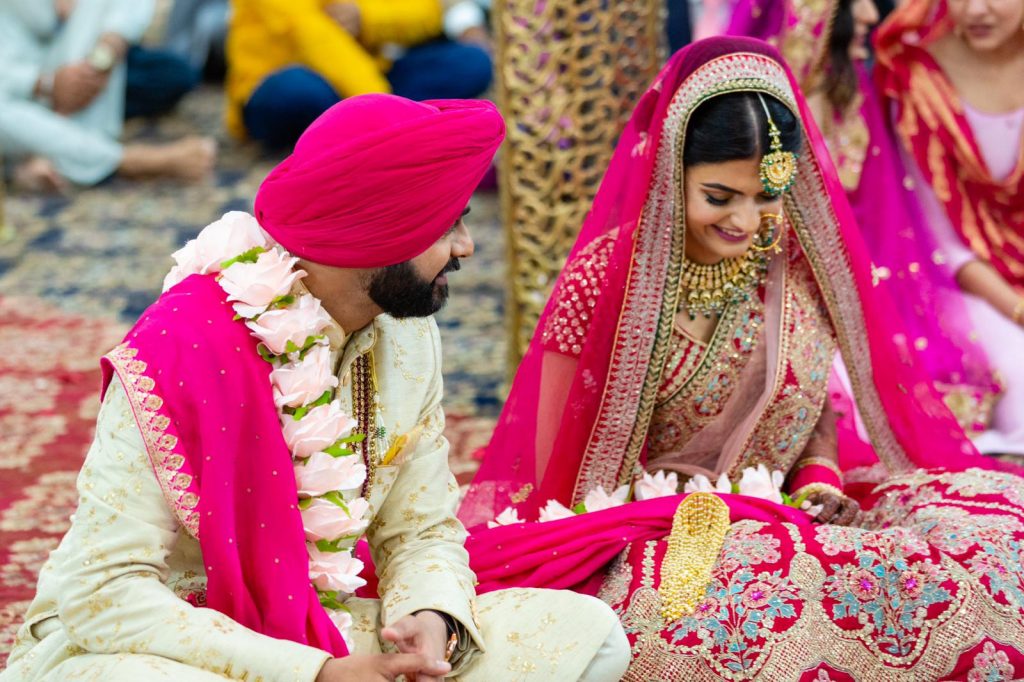
Kanyadaan and Phere: The bride’s father gives the bride to the groom after putting a ring on the groom’s finger in the Kanyadaan ceremony. A sacred fire is lit, and the couple circles the fire seven times as part of Hindu Punjabi wedding rituals. The groom then applies Sindoor to the bride’s forehead and ties a Mangalsutra to the bride’s neck in Hindu Punjabi wedding traditions. If the wedding is between a Sikh couple they also walk around the Guru Granth Sahib four times in a ritual called the Laavaan. The couple touches the feet of all the elders present to get their blessings.
Joota Chupai: The bride’s sisters playfully hide the groom’s shoes and demand a fee of Kalachuris of gold or silver in return for the shoes.
Punjabi Post Wedding Rituals
Vidaai/Doli: The Vidaai is the bride’s departure from her parental house. As she leaves she throws Phulian or puffed rice over her head to signify her good wishes to her parents. This is usually a sad ritual as the bride’s family cries to see her leave her childhood home. She then bids goodbye to her near and dear and is led towards the groom by her brothers. She leaves for her marital home. The bride’s relatives throw coins after the couple’s procession. The bride’s mother-in-law does not attend as she will be preparing for the bride’s arrival at the groom’s home. When the couple arrives, the groom’s mother encircles the bride’s head with a glass of water thrice and drinks it as acceptance of her as a daughter.
Pani Bharna: The bride enters the home by knocking over a mustard oil container at the home entrance. The newlywed couple offers pooja and then touches the feet of all the elders present. This is called the Matha Tekna. The entire wedding party spends the evening playing traditional games.

Phera Dalna: The bride’s brother picks the couple up, and they visit the bride’s home on the day after the wedding.
Songs and music are both an essential part of the modern Punjabi Hindu wedding. Many traditional songs are sung for each of the ceremonies, and they add their own cultural flavour to the rituals.








